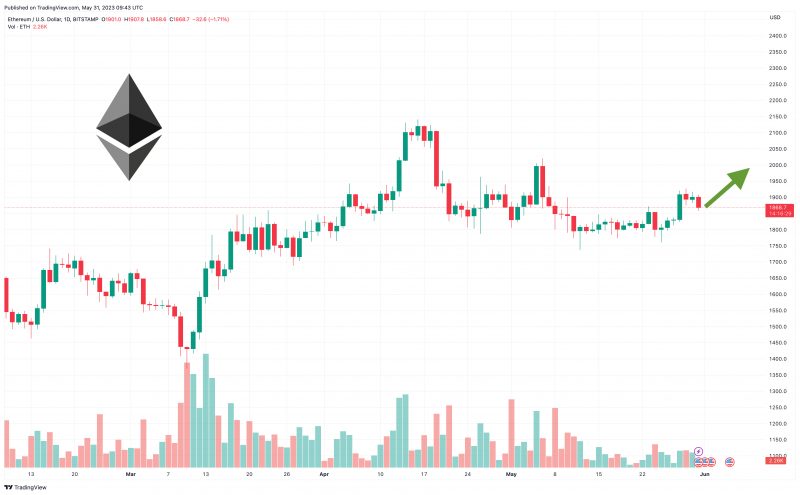The price of Ethereum has declined by 1.5% in the past 24 hours, with its fall to $1,869 coming as the wider cryptocurrency market drops by roughly the same percentage today.
ETH is now 3% up in the past week and only 1% up in the last 30 days, although the biggest altcoin has risen by 56% since the beginning of the year.
Encouragingly, ETH has also risen by 5% since last Thursday, when it declined to a two-week low of $1,775.
This suggests it may be gradually building momentum, and with the altcoin still arguably very undervalued, it could rally big in the not-too-distant future.
Ethereum Price Prediction as ETH Rallies Up From Recent Bottom – Is Now a Good Time to Buy?
While ETH has dipped, this means it’s now due a rebound, as signalled by its various technical indicators.
Its relative strength index (purple) plunged below 30 earlier today, suggesting that it has been oversold by traders and is now at a steep discount.
On the other hand, ETH’s 30-day moving average (yellow) hasn’t fallen below its 200-day average (blue) just yet, so a few more days of falling may be needed before it fully recovers.
That said, the coin’s rising support level (green) would indicate that it won’t fall too far, and that now may be the time to buy, before big gains arrive.
And looking at Ethereum’s enviably strong fundamentals, the cryptocurrency really should rally big this year.
For one, the implementation of staking has revealed considerable demand for ETH, with the introduction of withdrawals in April not actually leading to a flood of selling.
It’s actually quite the opposite, seeing as how the quantity of staked ETH has increased from about 18 million in April to 21.5 million today, .
This means that approx. 18% of ETH’s total circulating supply is now staked, yet what’s bullish is that this percentage could rise to somewhere between 40% and 60%, judging by .
In other words, substantial quantities of ETH are going to be taken out of circulation, increasing demand relative to supply and likely boosting ETH’s price.
On top of this, the transition to staking (which has reduced the issuing of new tokens) and the introduction of fee burns (via EIP-1559) means that Ethereum now has tendency to deflate, depending on how busy it becomes.
Again, this will reduce the available supply of ETH, in turn squeezing its price upwards.
Then there’s the fact that Ethereum remains the most widely used layer-one blockchain by quite some margin, with the platform accounting for roughly 57.8% of the entire DeFi sector.
This indicates substantial adoption, and it’s highly arguable that when the next bull market rolls around, Ethereum’s pre-existing network effects will result in it attracting disproportionately more users than its rivals.
Such a claim is supported by how major adoption news tends to involve Ethereum, with , and with .
Taken together, such pieces of news suggest that Ethereum is going to remain the dominant layer-one platform for the forseeable future, and that ETH will rise in parallel with its growth.
Indeed, from ETH’s current price of around $1,870, the market could expect it to reach $2,000 in the next few months, with the end of the year potentially seeing it rise as high as $2,500 or $3,000, depending on how bullish investors become.
A High-Potential Alternative
While Ethereum’s fundamentals are very solid, its status as a well-established coin may mean that it doesn’t experience too many big rallies in the future, and instead rising gradually over the longer term.
As such, traders looking for market-beating gains may also consider diversifying their portfolios to include high-potential alternatives, with a number of presale tokens currently promising to rally big when they list on exchanges in the next few months.
This includes , an Ethereum-based recycle-to-earn platform that has raised more than $4.4 million in the presale for its ECOTERRA token.
Scheduled to launch in the second half of the year, Ecoterra’s platform offers users the chance to receive ECOTERRA and NFTs as rewards for recycling household waste at participating recycling points.
Its platform and app will also reward users for providing proof of their use of renewable energy, while it will also incorporate a carbon offset marketplace, enabling users to trade carbon credits as NFTs.
Such an ambitious ecosystem has helped ecoterra’s sale attract interested investors, with the token offering currently in its seventh stage, with 1 ECOTERRA costing $0.008500.
This will rise to $0.001 by the time the sale ends in the next few weeks, although ECOTERRA’s price could really surge once it lists on exchanges.

